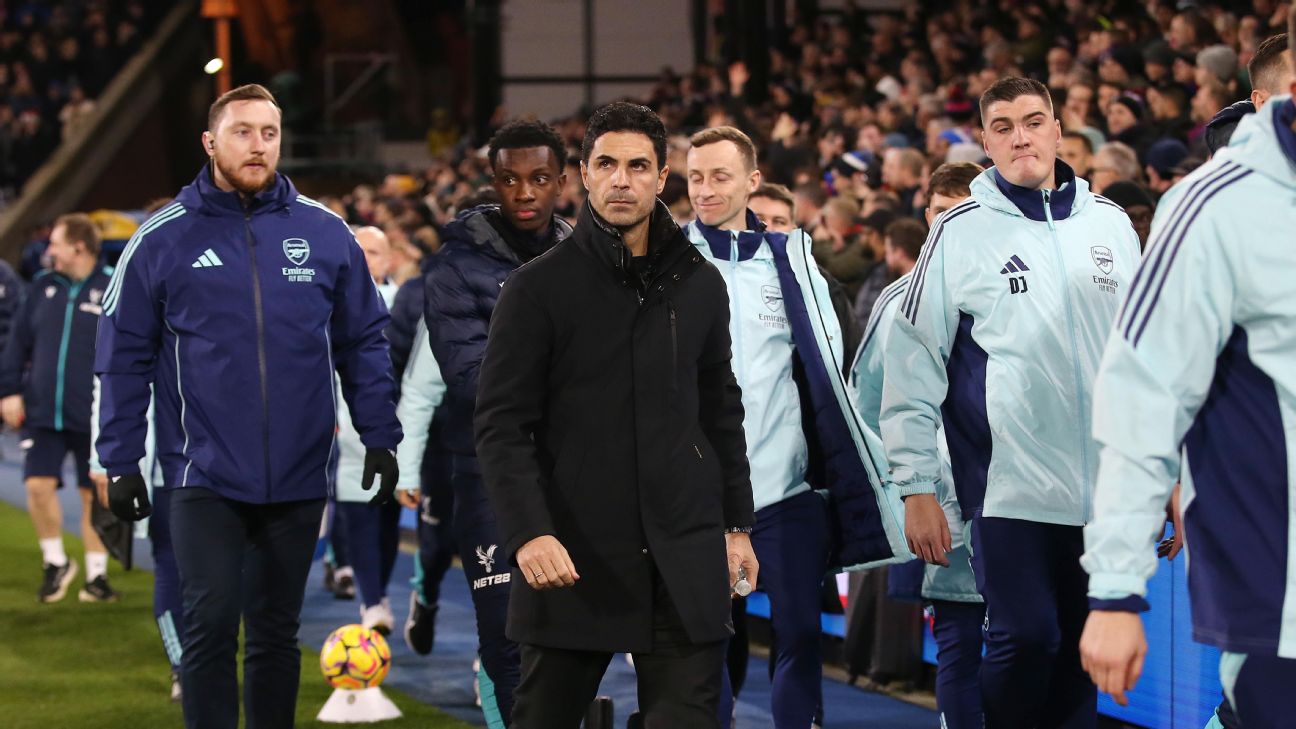SAN DIEGO — Closer to water polo than a game of soccer, Wednesday’s Concacaf W Gold Cup semifinal win for the United States women’s national team over Canada played out as a bizarre rainy spectacle at Snapdragon Stadium.
With stormy weather impacting a waterlogged field, any and all tactics immediately became irrelevant as 15,245 fans watched both sides fail to do much with a ball that became stuck every few yards in a 2-2 stalemate that was decided in a shootout.
“It’s obvious that the game was unplayable,” Canada coach Bev Priestman said. “We put in a lot of work in a game plan and within Minute 1, it’s thrown out the window.”
– Stream on ESPN+: NWSL, LaLiga, Bundesliga, more (U.S.)
Highlighting wider issues with how ill-prepared the venue was for the growing precipitation that peaked near halftime, thousands of supporters ducked underneath limited coverings at the canopy-less stadium. In the press box, a handful of media occasionally needed to protect their laptops when wind funneled rain into the area.
Looking toward the field, it felt like a pointless endeavor to attempt to analyze or make sense of what was happening when the ball sporadically stopped in ponds or zipped past shallow areas. Despite the drama that pushed the 1-1 semifinal into extra time, the late theatrics that featured two additional goals, the heroic efforts from USWNT goalkeeper Alyssa Naeher (three saves and a goal of her own in the 3-1 shootout victory), and the memorable chaos in the latest chapter of the North American rivalry, one question lingered: Should the waterlogged game have been played at all?
“Probably not,” USWNT interim coach Twila Kilgore said when asked that very question postmatch. “But those decisions aren’t my decisions and if the referees make those decisions, and the game goes on, it’s our job to figure out how to win.”
During the semifinal, ESPN reached out to Concacaf and asked whether the confederation or the officiating crew were responsible for deciding whether the game should be paused or postponed due to weather. In response, a Concacaf spokesperson said: “It is solely at the discretion of the referee as to whether the field is safe and playable.”
This is in line with 2023-24 rules from the International Football Association Board (IFAB), which indicates in Section 7 of Law 5 that officials have the right to make a decision “that the condition of the field of play or its surrounds or that the weather conditions are such as to allow or not to allow a match to take place,” although there are no specifications for the exact weather conditions or state of the field.
Should referee Katia Garcia then be questioned for not stopping the semifinal? To her credit, Garcia tested out ball movement a few times throughout the first 90 minutes and appeared to recognize that it was not moving as it should. Why she then didn’t delay or postpone the game was highlighted by CBS Sports contributor and referee Christina Unkel, who noted that a decision to pause the knockout match didn’t solely land on the shoulders of Garcia.
“Technically and practically, by law, it is always in the ultimate decision of the referee to make that decision,” Unkel said on CBS Sports. “That being said, practically speaking, there is a match commissioner at each of these Concacaf matches and as we saw within the first early minutes of this game, the referee went and demonstrated that the ball was not in fact rolling when she went over to near the fourth official station, which is where the match commissioner stands.
“I want to be very, very clear, it was very clear from her demonstrative showing that she does not necessarily think this is a safe condition but is being told to continue this match by that match commissioner.”
Rules expert, @ChristinaUnkel breaks down the regulations behind tonight’s waterlogged pitch and the decision to move forward with this semifinal match🙃 pic.twitter.com/kVvfNDuvkC
— Attacking Third (@AttackingThird) March 7, 2024
In an Olympic year in which teams like Canada and the U.S. are preparing to fight for gold medals, it’s important to keep those safe conditions in mind.
As entertaining as the semifinal was, and as significant of a boost this was for a U.S. side that has shown some gutsy performances since its historic loss to Mexico earlier in the tournament, most players should count themselves lucky that they didn’t suffer serious injuries. Outside of Canada’s Vanessa Gilles being substituted out because of concussion protocols, no other major setbacks emerged during the semifinal.
“Why are the players being put in this situation? No chance these are safe playing conditions,” former U.S. player Sam Mewis said on social media, while USWNT legend Julie Foudy posted: “Why isnt CONCACAF calling this match. Play it tmrw. Someone is going to get hurt.”
What’s additionally worrisome is that one doesn’t have to look too far back to find an even more dubious playing field. On Sunday, an AFC U20 Women’s Asian Cup match between Australia and South Korea was played on snow that was reportedly 6 inches deep.
In an MLS game the day before, Real Salt Lake hosted LAFC amid snow and thunder. After LAFC coach Steve Cherundolo complained that it was “an absolute joke that we had to play today. Not safe for the players. One of the worst professional sporting events I’ve ever seen in my life,” he was fined $10,000
For Snapdragon Stadium, which will host Sunday’s W Gold Cup final between the U.S. and Brazil, this is another unfortunate blemish for the venue when it comes to high-profile women’s matches. During last season’s NWSL semifinal between the San Diego Wave and OL Reign, Snapdragon Stadium was heavily criticized for the poor state of the field and markings leftover from a college football game.
Days later, the pitch conditions at Snapdragon Stadium made significant and notable improvements when it hosted the 2023 NWSL championship game between the OL Reign and NJ/NY Gotham FC, but also saw a non-contact Achilles tear for former USWNT winger Megan Rapinoe. Despite the fact that Rapinoe stated that the field had nothing to do with her sixth-minute injury, in what was already due to be the final match of her career, many eyebrows were raised.
And now, once again following a semifinal with questionable field conditions, Snapdragon Stadium will host a women’s championship Sunday. To the relief of Concacaf, the forecast for Sunday calls for the type of weather you’d expect in San Diego. But one shouldn’t forget the responsibilities for all involved when it comes to player safety.
Regardless of the entertainment and spectacle on hand, which was undoubtedly a roller coaster of thrilling sporting emotions, it was still a risky one to have with no delay or postponement. Because as the coaches said after the semifinal, Wednesday’s game should not have been played.



